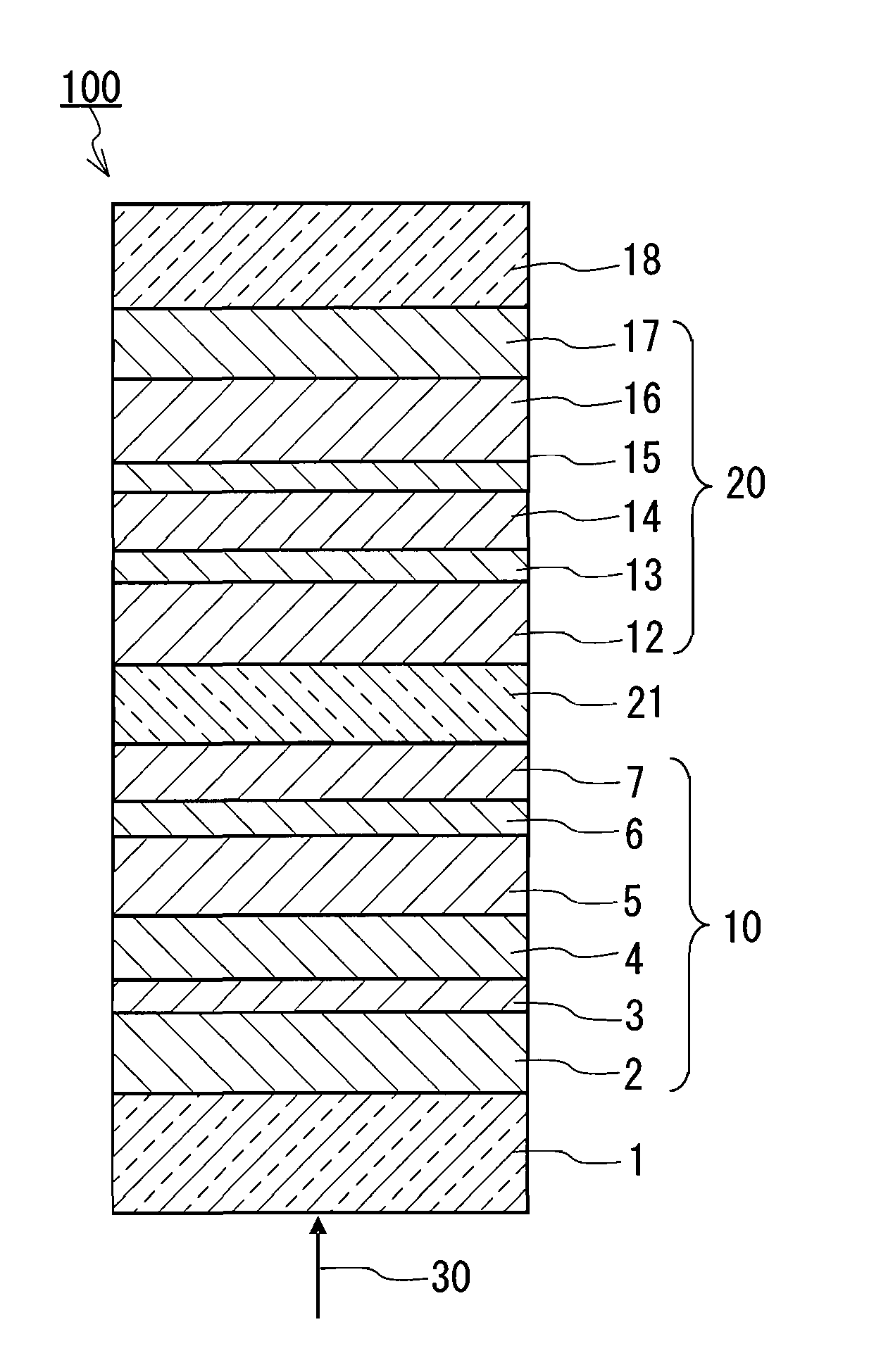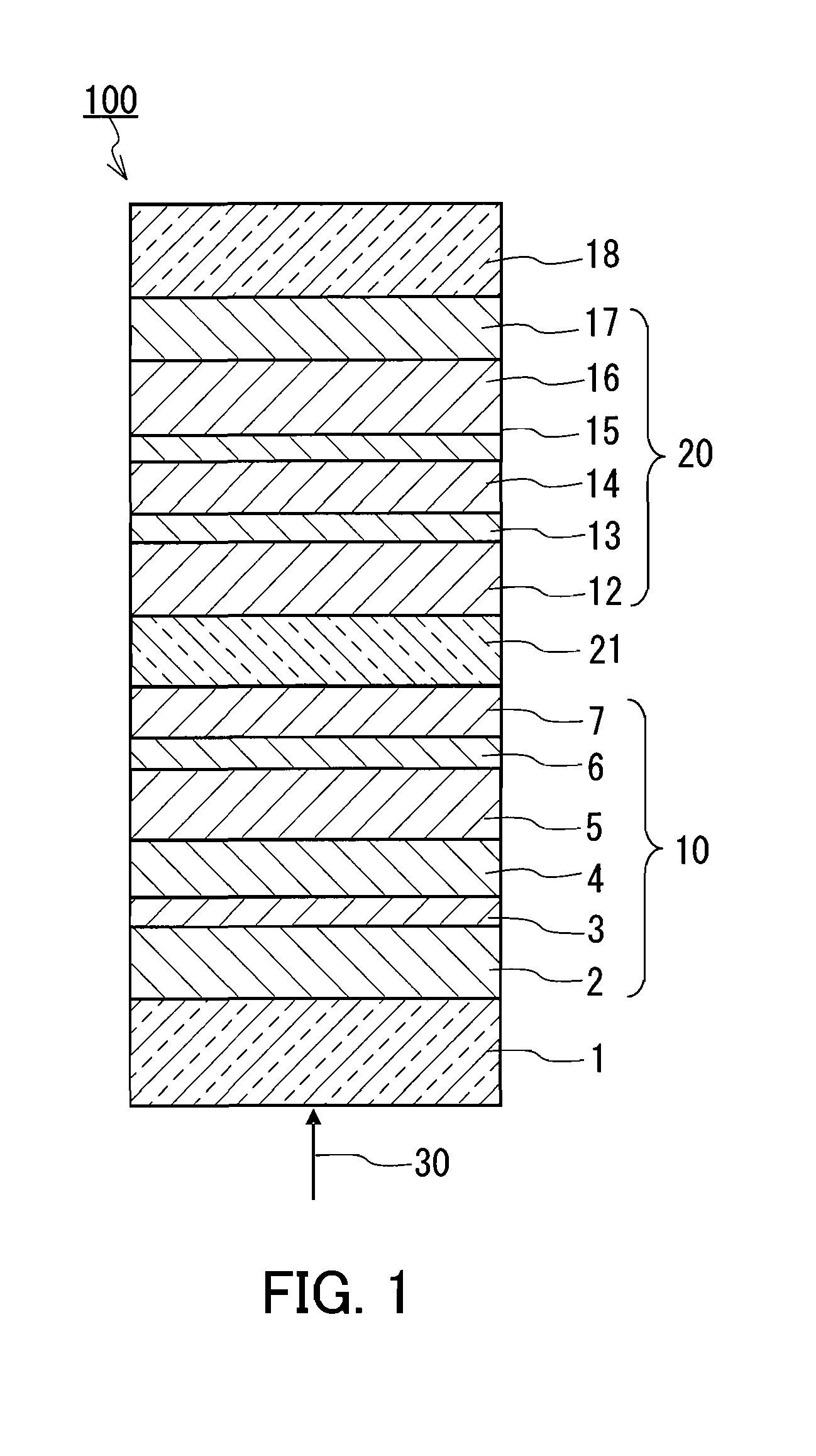Optical information recording medium and method for manufacturing the same
- Summary
- Abstract
- Description
- Claims
- Application Information
AI Technical Summary
Benefits of technology
Problems solved by technology
Method used
Image
Examples
example 1
[0085]The optical information recording medium of Example 1 was produced as follows. The optical information recording medium produced in the present example had the same film structure as that of the optical information recording medium 100 shown in FIG. 1, except that the first upper interface layer was provided further between the first recording layer 4 and the first upper protective layer 5. The optical information recording medium of the present example will be described below using the numerals shown in FIG. 1.
[0086]First, a 1.1 mm-thick polycarbonate substrate (120 mm in diameter and 1100 μm in thickness) with guide grooves transferred thereon was used as the first substrate 18.
[0087]Then, the second information layer 20 was formed on the polycarbonate substrate by stacking sequentially an Ag—Pd—Cu layer (100 nm in thickness) as the second reflective layer 17, a ZrO2—Cr2O3 layer (12 nm in thickness) as the second upper protective layer 16, a ZrO2—SiO2—Cr2O3 layer (2 nm in th...
example 2
[0114]The optical information recording media were produced in the same manner as in the Example 1, except that a sputtering target made of a mixture of 30 mol % of Bi2O3 powder and 70 mol % of TiOx powder (x=1.6 to 1.8) was used as the sputtering target for forming the transmittance adjusting layer 7. The optical information recording media of Example 2 also were measured for each of the properties by the same method as in Example 1 and evaluated for each of the characteristics.
[0115]In the Example 2, the sputtering rate was 5.8 nm / s (average of ten samples). As for the optical constants of the thin film (the transmittance adjusting layer) measured separately, the refractive index n1 was 2.77 and the extinction coefficient k1 was 0.03. The variation rate of the sputtering rate was 4.5% at this time.
[0116]When measured with the wavelength dispersive X-ray microanalyzer, the composition of the thin film (the transmittance adjusting layer) was composed of 16.6% of Bi, 19.3% of Ti, and...
example 3
[0119]The optical information recording media were produced in the same manner as in the Example 1, except that a sputtering target made of a mixture of 40 mol % of Bi2O3 powder and 60 mol % of TiOx powder (x=1.6 to 1.8) was used as the sputtering target for forming the transmittance adjusting layer 7, and the oxygen concentration during sputtering was 2.5 vol %. The optical information recording media of Example 3 also were measured for each of the properties by the same method as in Example 1 and evaluated for each of the characteristics.
[0120]In the Example 3, the sputtering rate was 7.65 nm / s (average of ten samples). As for the optical constants of the thin film (the transmittance adjusting layer) measured separately, the refractive index n1 was 2.77 and the extinction coefficient k1 was 0.05. The variation rate of the sputtering rate was 4.0% at this time.
[0121]When measured with the wavelength dispersive X-ray microanalyzer, the composition of the thin film (the transmittance...
PUM
| Property | Measurement | Unit |
|---|---|---|
| Thickness | aaaaa | aaaaa |
| Thickness | aaaaa | aaaaa |
| Thickness | aaaaa | aaaaa |
Abstract
Description
Claims
Application Information
 Login to View More
Login to View More - R&D
- Intellectual Property
- Life Sciences
- Materials
- Tech Scout
- Unparalleled Data Quality
- Higher Quality Content
- 60% Fewer Hallucinations
Browse by: Latest US Patents, China's latest patents, Technical Efficacy Thesaurus, Application Domain, Technology Topic, Popular Technical Reports.
© 2025 PatSnap. All rights reserved.Legal|Privacy policy|Modern Slavery Act Transparency Statement|Sitemap|About US| Contact US: help@patsnap.com


